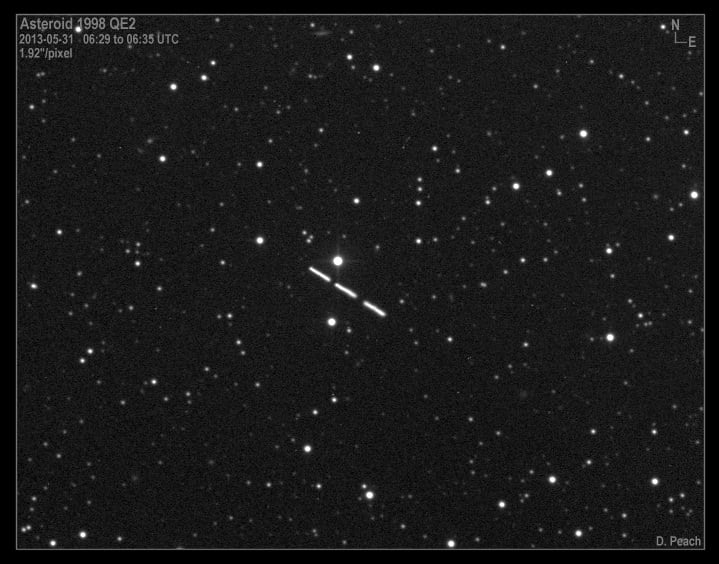Will the flyby of Near Earth Asteroid 285263 (1998 QE2) reveal more surprises? NASA announced yesterday that radar images uncovered a previously unknown
small moon orbiting the big asteroid.
Now, observatories and amateurs around the world are taking a look at this big, dark space rock, which is about 2.7 kilometers (1.7 miles) in diameter. Here are some of the "early returns" just in!
This asteroid will pass 5.86 million km (3.64 million miles) from the Earth on Friday, May 31st at 20:59 Universal Time (UT) or 4:59PM EDT. That is about 15 times the distance between Earth and the Moon, so no worries. But it is not often an asteroid this big comes by within viewing range of observatories on Earth.
[caption id="attachment_102564" align="aligncenter" width="580"]
Asteroid (285263) 1998 QE2, on May 31, 2013, taken remotely from the H06 iTelescope Observatory in New Mexico. Credit and copyright: Ernesto Guido and Nick Howes, Remanzacco Observatory. [/caption]
The Remanzacco Observatory team of Ernesto Guido and Nick Howes provided this image, above, and a great animation of the asteroid, as well:
[caption id="attachment_102565" align="aligncenter" width="580"]
Asteroid 1998 QE2 on May 28, 2013. Credit and copyright: Gianluca Masi, Ceccano, Italy; Virtual Telescope Project. [/caption]
Masi also provided a video from his May 30 observations:
[caption id="attachment_102571" align="aligncenter" width="580"]
Animation of Asteroid 1998 QE2, May 31, 2013 taken remotely with iTelescope T9. Credit and copyright: Ian Musgrave. [/caption]
Here's one from
Ian Musgrave.
If the animation isn't working in your browser, click on the image to animate. Ian also has provided this graphic made from
Celestia software
to show Asteroid 1998 QE2's orbit:
[caption id="attachment_102572" align="aligncenter" width="580"]
Orbit of 1998 QE2 simulated in Celestia at closest approach on May 31 20:59 UT. Via Ian Musgrave. [/caption]
Want to try and see this asteroid for yourself? Our very own
David Dickinson has written a great "how-to" for this object
, but you are going to need a fairly large backyard telescope, since it will be about 100 times fainter than what can be seen with the naked eye, even at closest approach.
The Slooh online telescope will have views of online tomorrow, which you
can watch at their website.
The webcast will start at 20:30 UTC (4:30 p.m. EDT) on Friday, May 31.
Also, starting at 20:00 UTC (4:00 p.m. EDT), astrophysicist Gianluca Masi will have a webcast from the
Virtual Telescope Project
in Italy.
Also, if you want more asteroids, on Friday May 31, the White House is hosting an asteroid-themed "We the Geeks" Google+ Hangout starting at 2 p.m. EDT.
The live video conference will feature Bill Nye the Science Guy, JL Galache from the Minor Planet Center, former astronaut Ed Lu, NASA Deputy Administrator Lori Garver, and Peter Diamandis, co-founder of asteroid mining company Planetary Resources. They will discuss identification, resource potential and threat of asteroids.
Here's the link the White House's Google+ page.
We'll be adding more images as they come in.
 Universe Today
Universe Today
